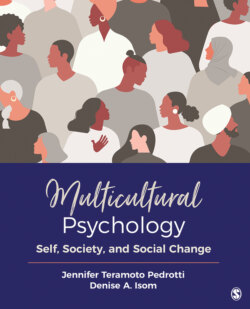Читать книгу Multicultural Psychology - Jennifer T. Pedrotti - Страница 14
На сайте Литреса книга снята с продажи.
A History of Pathologizing
ОглавлениеAs a field, psychology has not always paid attention to culture and context in making efforts to understand different human behavior and experience, and it has not always been kind to those viewed as “different” in some way. Specifically, psychology, born of Western roots in Europe, has often pathologized those who didn’t fit the cultural mold of the prominent early European theorists. In the early 1900s, H. H. Goddard, a psychologist who studied the concept of intelligence, put forth the idea that the particular shape and definition of a person’s face allowed him to be able to predict the intelligence associated with that person (Gould, 1996). Individuals with “Roman noses” and “high brows” were the most intelligent, while those with lower brows were less intelligent. We have some vestiges of this notion even in our colloquial language today, where “highbrow” humor is thought to be more intellectual humor. Unsurprisingly, Goddard and colleagues’ own facial features seemed to mirror the descriptions of those who were most intelligent.
Other beliefs about different groups were also held at this time, often spurred by differences from the European ideal, and these influenced psychological theories as well. For example, in the early 1800s, the idea of polygenism was taking hold in many areas of Europe. At the time this theory emerged, many still adhered to the religious explanations that all humans had descended from one particular line of genes (namely that of Adam and Eve from the Judeo-Christian Bible), but polygenism promoted the idea that different types of humans might have emerged from different genetic pools (Keel, 2013). Dr. Josiah Nott, an American physician, published a paper titled Two Lectures on the Natural History of the Caucasian and Negro Races that presented the idea that the different racial groups could not have developed such distinct features (e.g., skin color) due solely to the environment in such a short amount of evolutionary time. This was a hotly contested point of view at the time because of its dissension from biblical explanations for the genesis of human life, but it also appealed to some individuals, as it appeared to label race as a biological and genetic difference.
Around this same time, Charles Darwin and his theories regarding evolution also began to emerge. While the tenets of Darwinism are in opposition to polygenism in the sense that Darwin did not believe that the different races had completely different origins, his ideas (now the basis of social Darwinism) put forth the premise that different racial groups might actually be evolving differently such that they were becoming different species. These ideas, which again complemented the societal views of race at the time, quickly gained popularity in Europe. The influence of this theory led many to believe that individuals of African or Asian descent were incapable of the same type of intelligent thought as those from Europe. In making these decisions, cultural context was ignored, and behaviors were only judged from the mindset of a European cultural scholar. Though these theories and ideas are from the past, they form the basis for many stereotypes that exist about non-White groups that are held today.
